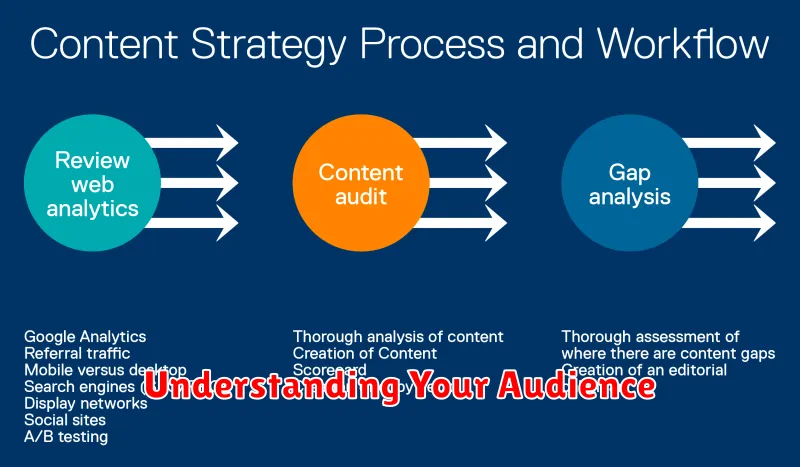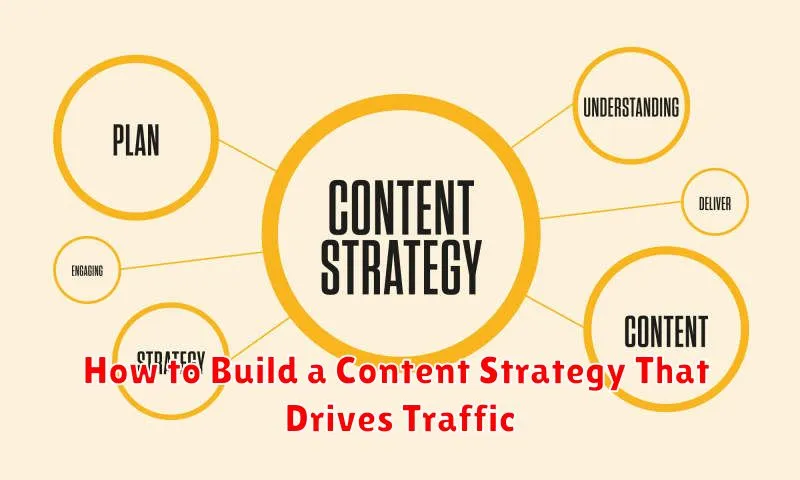In today’s digital landscape, a robust content strategy is no longer a luxury, but a necessity. It’s the backbone of successful online presence, driving traffic, generating leads, and ultimately, achieving business objectives. This article will provide a comprehensive guide on how to build a content strategy that effectively drives traffic to your website, transforming casual visitors into engaged customers. We will delve into the key components of a winning strategy, from understanding your target audience and conducting keyword research to creating high-quality content and promoting it effectively. Learn how to harness the power of a well-defined content strategy to boost your website’s visibility and achieve measurable results.
Building a content strategy that drives traffic requires a meticulous approach, encompassing various crucial elements. From defining clear goals and understanding your target audience to crafting compelling content and promoting it strategically, each step plays a vital role in achieving success. This article will equip you with the knowledge and tools necessary to create a content strategy that not only attracts traffic but also nurtures leads and drives conversions. Discover actionable insights and practical tips to build a content strategy that sets you apart from the competition and establishes your online presence as a leader in your industry.
The Role of Content in Digital Success
In today’s digital landscape, content plays a critical role in achieving online success. It serves as the foundation for engaging your target audience, driving traffic to your website, and ultimately, achieving your business objectives.
High-quality content helps establish your brand as an authority in your industry, building trust and credibility with potential customers. It provides valuable information that addresses their needs and pain points, positioning your business as a valuable resource.
Effective content also fuels search engine optimization (SEO) efforts, improving your website’s visibility in search results and attracting organic traffic.
Understanding Your Audience

Knowing your audience is the foundation of a successful content strategy. Without a clear understanding of who you’re creating content for, your efforts will likely be scattered and ineffective.
Consider these key aspects: demographics (age, location, gender), psychographics (interests, values, lifestyle), and their online behavior. What platforms do they frequent? What kind of content do they engage with? Answering these questions will guide your content creation process.
Choosing the Right Content Formats
Selecting the right content formats is crucial for effectively reaching your target audience. Consider your audience’s preferences and the type of information you’re sharing. Blogs are excellent for delivering valuable insights and driving organic traffic through SEO. Videos excel at explaining complex topics and engaging viewers on platforms like YouTube. Infographics present data in a visually appealing manner, easily shareable across social media. Podcasts offer convenient consumption for listeners on the go.
Matching the format to your message ensures optimal engagement and impact. Think about which format best showcases your content and resonates with your target audience.
Content Calendar and Planning
A content calendar is a crucial tool for organizing and scheduling your content marketing efforts. It provides a clear overview of what content will be published, when, and on which platform. This organized approach ensures consistent output and prevents last-minute scrambling for ideas.
Planning your content in advance allows for strategic alignment with your overall marketing goals. Consider seasonal trends and key events when scheduling your content to maximize relevance and potential reach.
Topic Clusters and SEO Pillars
Topic clusters and SEO pillars are a powerful way to organize your website content. A pillar page serves as the central hub, covering a broad topic. Cluster content, addressing specific aspects of that topic, links back to the pillar, creating a web of interconnected information.
This structure benefits SEO by demonstrating expertise and authority to search engines. Internal linking between pillar and cluster content strengthens relevance and improves search rankings for related keywords. It also provides a clear and user-friendly experience for visitors navigating your website.
Keyword Mapping for Each Stage
Effective keyword mapping ties specific keywords to each stage of the buyer’s journey. This ensures your content resonates with the audience’s current needs and guides them towards conversion.
Awareness Stage: Focus on broader, informational keywords related to the problem your product or service solves. Think about questions your target audience might be asking.
Consideration Stage: Shift to more specific keywords reflecting solution-seeking behavior. These keywords often include comparisons, reviews, or benefits.
Decision Stage: Target transactional keywords demonstrating purchase intent. These might include specific product names, pricing inquiries, or “buy now” related terms.
Repurposing Existing Content
Repurposing content is a powerful strategy to maximize your content marketing efforts. It involves transforming existing high-performing content into new formats to reach a wider audience and extend its lifespan.
For instance, a popular blog post could be repurposed into an infographic, a series of social media posts, or even a short video. This not only saves time and resources but also strengthens your message by presenting it in various engaging ways.
By strategically repurposing content, you can increase visibility, attract new followers, and reinforce your key messages across different platforms.
Measuring Performance and Adjusting
Analyzing content performance is crucial for optimization. Track key metrics such as website traffic, bounce rate, time on page, and conversion rates.
Use analytics tools to understand which content pieces are performing well and which ones need improvement. This data-driven approach helps identify areas for adjustment in your content strategy.
Regularly review and refine your approach based on the performance data to ensure your content continues driving traffic and achieving your desired goals. Adapt your strategy by creating more of what works and less of what doesn’t.
Tools for Managing Content Workflow
Managing a complex content strategy requires the right tools. Content workflow management tools help streamline the creation, editing, approval, and publishing processes. These platforms facilitate collaboration, automate tasks, and ensure consistency.
Several options are available, from robust enterprise solutions to more lightweight project management tools. Choosing the right one depends on the size of your team and the complexity of your content strategy. Key features to consider include editorial calendars, task assignments, and version control.
Real Examples from Top Brands
Examining successful content strategies provides valuable insights. Let’s explore how top brands leverage content to drive traffic.
Example 1: HubSpot
HubSpot, a leader in inbound marketing, uses blog posts, case studies, and free resources to attract and engage their target audience. This strategy positions them as thought leaders and drives significant traffic to their website.
Example 2: GoPro
GoPro focuses on user-generated content, showcasing the capabilities of their cameras through breathtaking videos. This approach builds community and inspires potential customers.

